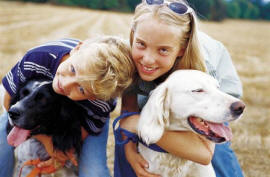
Click on
Library Icon
to learn more
|
Introduction
Keep children
safe by teaching them to recognize potentially.jpg) threatening canine
communication.
If children do not recognize
canine threat postures, they may
be bitten or worse.
threatening canine
communication.
If children do not recognize
canine threat postures, they may
be bitten or worse.
Pet-child interactions
can be wonderful
for pets and children when
teaching a child to be gentle and
respectful to animals. Studies show that
animal abuse in children is correlated
to adult aggression to people.
Teaching your children to be humane
helps build a healthier society.
Supervision is the key
Supervise children until you
are SURE they are trustworthy
and know how to treat and
respond safely to the dog.
When you first introduce
children to dogs, use a positive, calm
yet jolly voice tone and have the dog on-leash
(preferably with a head
collar/halter). Pick a time when
the dog has been exercised and is
relaxed.
You want the dog to think that
children are powerful, friendly cookie
givers. Stand behind the
child and put your hand on the child's
hand as you ask the dog to sit for a
treat. Show
the child how to close an upward
fist when asking for the sit and then
opening the fingers to a flat hand to
deliver the treat when the dog sits.
Show the child how to
approach the dog and stroke the
dog from the side, not from the
front, and to not on the
dog's head. Instruct the
child to ask the dog to sit or down for
a treat or ball and to be stroked. Make
sure the child gives the dog loving
praise along with the treat or toy for
compliance.
Remind children
never to shriek or wave their
hands wildly around around dogs.
Instead, have children
demonstrate to you how they move slowly
around dogs with their
hands at their sides, speaking
in a calm, happy voice tone.
|
One reason we enjoy pets is
because we can cuddle and
play with them. This
joy can turn into injury of
the pet or the person if guidelines are not
followed. |
 It's best and safest for the
child if the dog
perceives every human in the
household as controlling all the
dogs favorite needs and wants
such as food, toys, access in
and out of doors, etc. It's best and safest for the
child if the dog
perceives every human in the
household as controlling all the
dogs favorite needs and wants
such as food, toys, access in
and out of doors, etc.
Young
children, even toddlers, can
learn to ask the dog to sit
before releasing a food treat
but ONLY if the adult is RIGHT
BEHIND them as back up to avoid
the dog jumping and knocking
over the child. The dog should
learn basic instructions from adults
first.
Guidelines for dog
cuddling
If the dog is small, you may
be able to have the child sit on the floor and then
place the dog in the child's lap to be stroked.
Make sure the dog is relaxed or
sleepy. You offer the dog treats as you instruct the
child how to gently stroke and cuddle the dog. If
your child wants to cuddle the dog, instruct the
child to sit on the floor and invite the dog to lay
on the child's lap. Begin a cuddling routine that
can continue throughout dog's entire life.
Most
people do not want the dog up on the furniture,
unless the dog is small and invited. Dogs who climb
on furniture at
will may leave dirt or other
material from outdoors along with shedding fur, fleas or flea
dirt on the furniture.
Big dogs may add to the wear
and tear of furniture, including your bed.
It is best to
begin house rules when the dog is a puppy.
It is harder on you and the dog
to start with one set of rules for the puppy and
then try to change the rules for the adult dog.

|